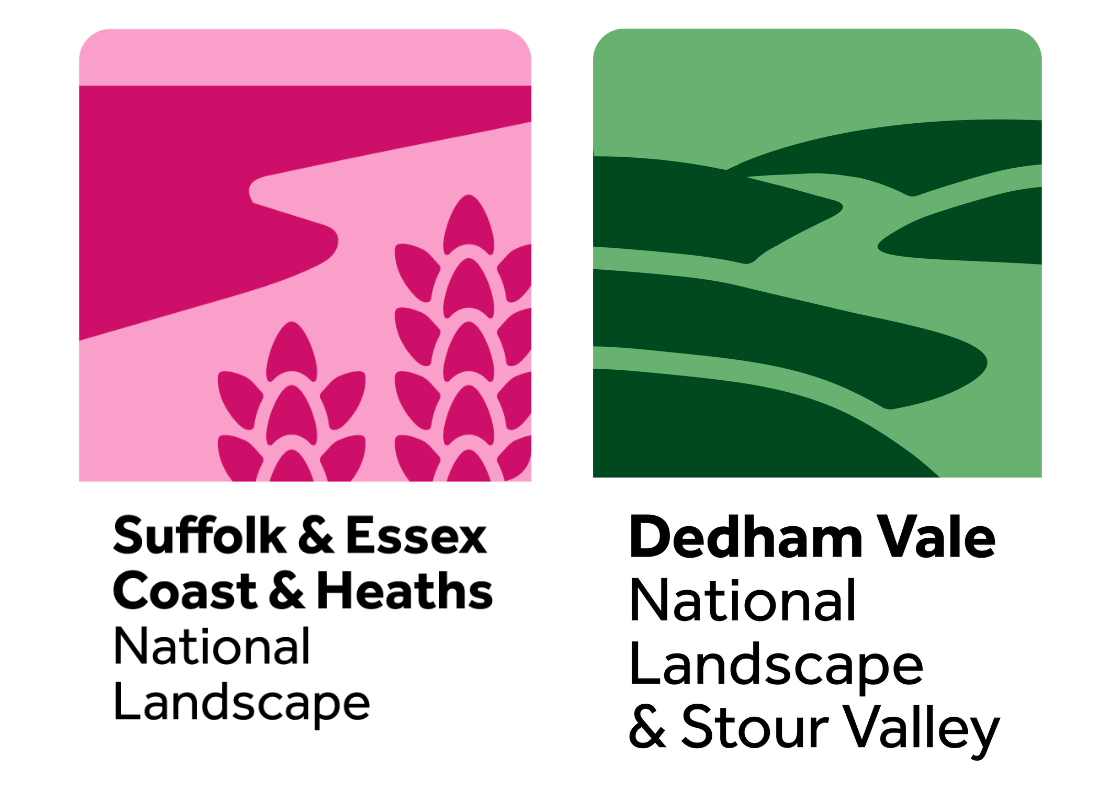Sustainable Development Fund
Publicity Guidance for grant funded projects

In the event of your project securing a grant award, your work is funded by one of the National Landscape grant giving programmes, working in partnership with a network of organisations to manage grants available to communities.
Your innovative work deserves recognition and we encourage you to strongly publicise your grant award - the National Landscape can work with you to support this. Publicity is a powerful tool to celebrate and promote the successes of your project, and for the National Landscape to monitor and evaluate grant funded projects.
The National Landscape and partners want it to be known that our funds are a part of your efforts to conserve and enhance the National Landscape, and so we ask that you give recognition of the funding support provided by the grant in any publicity.
This Publicity Guidance is to advise Sustainable Development Fund (SDF) grant funded projects on:
- Conditions and expectations of the Sustainable Development Fund
- Support available to your project from the National Landscape
- Mandatory use of logos
- Use of digital platforms
- Top tips for planning communications
1 Conditions of Offer - In acceptance of your grant award we ask that you:
Acknowledge - Give recognition of the funding support provided by the appropriate grant in any publicity - either ‘Suffolk & Essex Coast & Heaths National Landscape Sustainable Development Fund’ or ‘Dedham Vale National Landscape Sustainable Development Fund’.
It is mandatory that this acknowledgement should use the appropriate National Landscape logo and be included in any publicity for your completed project.
Suggested use of the following text:“This project has been [part] funded by the Suffolk & Essex Coast & Heaths National Landscape Sustainable Development Fund” or“This project has been [part] funded by the Dedham Vale National Landscape Sustainable Development Fund”.
Proof read – Before releasing any publicity, please request sign-off from the National Landscape Team. Ideally this should be at least one week before any proposed promotions. This will help to ensure that the grant logos have been used correctly, allow for proof-reading and confirm that there are correct references to the grant fund before release/printing.
Examples of publicity that needs to be signed off by the National Landscape Team are:
- Press releases
- Promotional materials and publications e.g. leaflets
- Displays
- Signage
- Artwork
- Reports
- Newsletter articles
- Maps
- Learning resources
- Books
- Presentations and web pages
Social media posts do not need to be signed off by the National Landscape Team but please ensure the appropriate tags in your social media post so we can support digital engagement with your project.
Provide evidence for final claim - Your project is required to provide publicity evidence in support of your final claim as follows:
A Final Monitoring Report including:
- Photos of the project (at least two) for publicity use with the appropriate consents in place
- Copies of relevant press releases and publicity, including digital coverage
- Demonstration of measurable success of your project e.g. social media posts/publicity records/statistics
- If there is a lot of publicity, choose a few ‘highlights’ from each media platform
- Feedback or quotes from participants
The SDF Panel and the National Landscape reserve the right to use any material submitted for publicity purposes.
2 Publicity support from the National Landscape Team
Plan ahead with your publicity and recognition of the grant award. Consider writing a brief communications plan and decide how you are going to record and evaluate your project publicity – For detailed guidance on thinking around project communications, and a worked example, see Section 5 ‘Top Tips from the National Landscape Team for planning communications.
Share your plans with the National Landscape Team so that we are aware and can be involved in the process. The National Landscape Team can support your project through its communication networks, so please contact us if there are any publicity opportunities for your project that we can help to maximise. Your National Landscape Team Contacts for publicity are:
- National Landscape Grants Officer (first point of contact) - Oka Last [email protected]
- National Landscape Communications Officer - Tom Fairbrother [email protected]
3 Use of Logos
The appropriate National Landscape logo should be used for all SDF publicity as shown:

4 Use of digital platforms
For all digital platforms (website, e mail signatures and social media) – Write about your project, featuring the fund logo(s) and mention the ‘Sustainable Development Fund’ grant support, ideally linking to the National Landscape website.
Suffolk & Essex Coast & Heaths National Landscape Social media links and tags:
Facebook Tag: @coastandheaths #SustainableDevelopmentFund
Facebook link: www.facebook.com/coastandheaths
Twitter Tag: @coastandheaths #SustainableDevelopmentFund
Twitter link: https://twitter.com/coastandheaths
Instagram Tag: @coastandheaths #SustainableDevelopmentFund
Instagram link: www.instagram.com/coastandheaths
Website: www.coastandheaths-NL.org.uk
Dedham Vale National Landscape Social media links and tags:
Facebook Tag: @dedhamvaleNL #SustainableDevelopmentFund
Facebook link: www.facebook.com/dedhamvaleNL
Twitter Tag: @DedhamValeNL #SustainableDevelopmentFund
Twitter link: https://twitter.com/DedhamValeNL
Instagram Tag: @dedhamvaleNL #SustainableDevelopmentFund
Instagram link: www.instagram.com/dedhamvaleNL/
Website: www.dedhamvale-NL.org.uk
5 Top tips for planning communications
Communication is a vital best practice for any project and it’s important to have a communications plan to guide your activities. This will breakdown what you hope to achieve, what you would like to say, to whom you would like to communicate and how you intend to do so.
A good communications plan should cover:
- Aims and Objectives
- Key messages
- Target audiences
- Proposed activities
- Measuring success
1 Aims and Objectives
In this section you should think about what it is you hope to achieve with your communications. Your aims and objectives will be unique to your project, but it’s important to be clear about what these are so that you can decide who and how to communicate.
2 Key Messages
Once you have decided upon your broader communication aims and objectives, you can then break these down further and identify your key messages. Whilst your aims and objectives are more strategic and outcome goals, your key messages are more granular in laying out what you intend to communicate to achieve them.
3 Target Audiences
Most projects will impact upon many different people in different ways to a greater or lesser extent and each will have varying degrees of knowledge or interest in
the project.
It’s important to identify these audiences so you can come up with a plan of action for communicating with each group as it’s very unlikely that a one size fits all approach will work – you will need to tailor your approach and your communication style, tone, language and format for each based upon their habits and needs.
4 Proposed Activities
There are many ways in which you can communicate your key messages with your target audiences and how you choose to do so is likely to depend on a variety of factors such as your resources and budget, who the target audience is, and what it is you are trying to communicate.
You can think of communications activities as a menu of options from which you can choose the most appropriate and suitable for each of your target audiences
based on their behaviour, needs and preferences.We have broken down some of the most common methods used and highlighted some of the pros and cons of each:
Leaflets
Leaflets are a useful way to share information as they are generally low in cost to print large quantities and can be placed at strategic locations for maximum exposure. However, leaflets can be time-consuming to design and produce and the information often goes out of date very quickly. It’s also difficult to track who and how many people have read with them and gather feedback, in addition to the environmental impact of printing and the possibility of littering.
The key with leaflets is to plan how you will distribute them and where the leaflets will be circulated before deciding to produce them. When designing the content you also need to think about who it is your target audience is and ensure that your language and tone is tailored accordingly.
Interpretation Boards & Signage
These are a great way to have a physical presence and communicate key message at important locations such as car parks, entrances, and hotspots. However,
interpretation boards and signage are they are often expensive options once you have allowed for costs of materials, design, production, installation, and
maintenance. Like leaflets, information can also go out of date and unfortunately there is always the possibility they are damaged or vandalised.
Posters
Posters offer many of the same benefits as interpretation boards and signage and additionally they are far cheaper to produce and therefore can be updated regularly. The downsides are they need to be attached to a surface and this can be difficult out in the field. Additionally, they are less durable and are prone to damage by the elements.
Face-to-face
Communicating face-to-face is a brilliant way to humanise key messages, listen to feedback, answer questions, and provide information and education. The downsides are it is very resource heavy, requiring either staff or volunteers, and it is hard to scale and reach large numbers of people compared with digital alternatives.
Events
Organising in-person events is a great way to provide a focal point and meet and engage with lots of different people. You can share information, listen to feedback, and build relationships. However, they can require lots of time to organise and costs to hire venues and produce resources and marketing materials for use on the day.
Social Media
Social media is a brilliant way to reach huge numbers of people with your key messages for free. Posts can be boosted and targeted for a very low cost to share timely and relevant information with very specific demographics, such as a geographic area, hobbies and interests, or age range. You can also see exactly how many people have engaged with posts.
The downsides of social media are that not everyone uses it, there is a lot of competition for eyeballs, and it relies upon an internet connection which may be an issue in more remote rural areas.
Websites
Similarly, websites are now where people, companies and organisations can share huge amounts of information, such as videos, documents, guides, news stories, all of which are available to access from any computer or phone, from any location, 24/7.
Information can be continually updated to ensure it is always accurate and relevant and you can monitor which content is most popular and use that to inform your communications.The downsides of relying on websites are they can be time-consuming to set up and costly and rely upon internet connections and visitors having the skills to navigate them.
Videos and webinars
Offering online events and webinars is a great way to reach large numbers of people for very low cost. Videos and webinars can be watched online without people needing to travel, shared on social media, and hosted on websites ensuring they reach people at different times or at a later date. However, not everyone has access or the skills to join webinars and you lose the human element. Video production also requires editing skills and equipment.
5 Measuring success
For the purposes of the Sustainable Development Fund, clear expectations are in place from the outset in terms of how your project will succeed. The requirements in terms of reporting are outlined in the Funding Criteria and Guidance for Applicants 2024-25 and, specifically for publicity, in this document from Section 1 Conditions.
